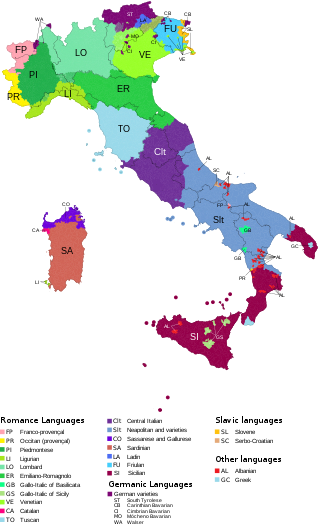
The languages of Italy include Italian, which serves as the country's national language, in its standard and regional forms, as well as numerous local and regional languages, most of which, like Italian, belong to the broader Romance group. The majority of languages often labeled as regional are distributed in a continuum across the regions' administrative boundaries, with speakers from one locale within a single region being typically aware of the features distinguishing their own variety from one of the other places nearby.
The twenty Italian regions each have their own arms, as well as their own gonfalone; more recently they have taken into use normal flags as well. Many regional flags were adopted on 4 November 1995 for National Unity and Armed Forces Day of Italy.
Flaminio Baudi di Selve was an Italian entomologist who specialised in Coleoptera but also Heteroptera.
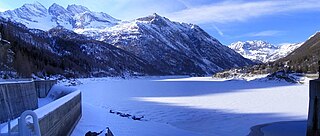
Lago di Ceresole is an artificial lake in the Province of Turin, Piedmont, northern Italy. The lake was created in 1925-1931 when A.E.M., Turin's electricity authority, built a dam with a hydroelectric plant. The site is located in what is now the comune of Ceresole Reale.

Bric delle Camere is a mountain in northern Italy, part of the Ligurian Apennines. It is located in the provinces of Genoa and Alessandria. It lies at an altitude of 1016 metres.

The Strona di Postua is a 14.1 kilometres (8.8 mi) long torrent in the Piedmont region of northwestern Italy.
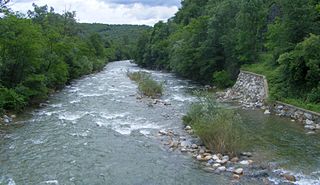
The Chiusella is a 41-kilometre (25 mi) long river in the Piedmont region of Italy.

The Borbore is a river of Piedmont, Italy. It is a left-side tributary of the Tanaro.

The Triversa is a river of Piedmont, Italy. It is a left-side tributary of the Borbore.
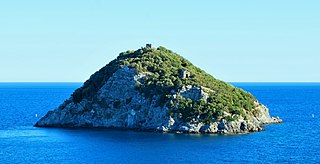
Bergeggi is an island which lies in the Ligurian Sea off the coast near the village of Bergeggi in the Province of Savona, Liguria, Italy.

The Alpe Veglia and Alpe Devero Natural Park was established in 1995 and is in the Ossola valley, in the Province of Verbania, Italy.
The Antola Natural Regional Park is a natural park in Metropolitan City of Genoa. It gets the name from the highest mountain of the area, Monte Antola.
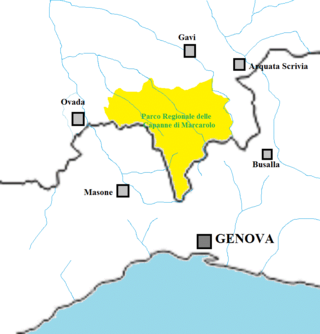
The Capanne di Marcarolo Natural Regional Park is a natural park in the province of Alessandria. It gets the name from a small village in the protected area, Capanne di Marcarolo.

The Stura di Ovada is a 32.9-kilometre (20.4 mi) stream of Liguria and Piedmont (Italy); it is the main tributary of the Orba.

Rocca Barbena is a 1,142-metre (3,747 ft) high mountain in the Ligurian Prealps in Italy.

The Monte Antoroto is a mountain of the Ligurian Alps located in Piedmont.
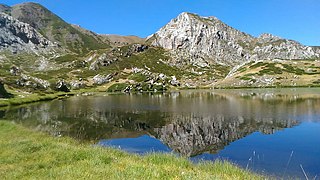
The Natural Park of Marguareis(in Italian Parco Naturale del Marguareis) is a regional natural park of the Ligurian Alps located in the Province of Cuneo.

The Punta Mirauda is a mountain of the Ligurian Alps located in Piedmont.

The Pietra Alta is a glacial erratic in the comune of Caselette, relevant for its size and its isolated location.
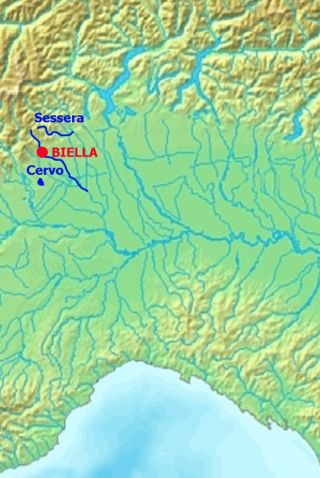
The hydrography of the Biella region, that is, the distribution of surface water in the province of Biella, Italy, falls almost entirely in the two basins of the Cervo and Sessera rivers, both tributaries of the Sesia. Some areas of the southwestern Biella region, on the other hand, are tributaries of the Dora Baltea; the largest natural body of water in the province, Lake Viverone, is also located in this area. In addition to the natural bodies of water, there are several irrigation canals in the plains built mainly to support rice cultivation and some reservoirs built in the foothills. In addition to irrigation, surface water is also used in the Biella area to serve the region's numerous industries and for potable water use, because the area is densely inhabited and groundwater capture is insufficient. Hydroelectric use, on the other hand, is very limited and is substantially confined to the Sessera Valley. The streams of the Biella region can be subject to ruinous floods as well, which have caused numerous damage to property and people over time.


















